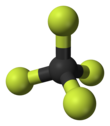Carbon tetrafluoride
| |||
| Names | |||
|---|---|---|---|
| IUPAC names
Tetrafluoromethane
Carbon tetrafluoride | |||
| Other names
Carbon tetrafluoride, Perfluoromethane, Tetrafluorocarbon, Freon 14, Halon 14, Arcton 0, CFC 14, PFC 14, R 14, UN 1982
| |||
| Identifiers | |||
3D model (JSmol)
|
|||
| ChEBI | |||
| ChemSpider | |||
| ECHA InfoCard | 100.000.815 | ||
| EC Number |
| ||
PubChem CID
|
|||
| RTECS number |
| ||
| UNII | |||
CompTox Dashboard (EPA)
|
|||
| |||
| |||
| Properties | |||
| CF4 | |||
| Molar mass | 88.0043 g/mol | ||
| Appearance | Colorless odorless gas | ||
| Density | 3.72 g/l, gas (15 °C) | ||
| Melting point | -183.6 °C (89.6 K) | ||
| Boiling point | -127.8 °C (145.4 K) | ||
| 0.005%V at 20 °C 0.0038%V at 25 °C | |||
| Vapor pressure | 3.65 MPa at 15 °C 106.5 kPa at -127 °C | ||
Refractive index (nD)
|
1.113 | ||
| Hazards | |||
| NFPA 704 (fire diamond) | |||
| Flash point | Non-flammable | ||
| Related compounds | |||
Other cations
|
Silicon tetrafluoride Germanium tetrafluoride Tin tetrafluoride Lead tetrafluoride | ||
Except where otherwise noted, data are given for materials in their standard state (at 25 °C [77 °F], 100 kPa).
| |||
Tetrafluoromethane, also known as carbon tetrafluoride, is the simplest fluorocarbon (CF4). It has a very high bond strength due to the nature of the carbon–fluorine bond. It can also be classified as a haloalkane or halomethane. Because of the multiple carbon–fluorine bonds, and the highest electronegativity of fluorine, the carbon in tetrafluoromethane has a significant positive partial charge which strengthens and shortens the four carbon–fluorine bonds by providing additional ionic character. Tetrafluoromethane is a potent greenhouse gas.
Bonds
Carbon–fluorine bonds are the strongest in organic chemistry.[1] Additionally, they strengthen as more carbon–fluorine bonds are added to the same carbon. In the one carbon organofluorine compounds represented by molecules of fluoromethane, difluoromethane, trifluoromethane, and tetrafluoromethane, the carbon–fluorine bonds are strongest in tetrafluoromethane.[2] This effect is due to the increased coulombic attractions between the fluorine atoms and the carbon because the carbon has a positive partial charge of 0.76.[2]
Chemistry
Pure tetrafluoromethane was first synthesised in 1926.[3]
Tetrafluoromethane can be prepared in the laboratory by the reaction of silicon carbide with fluorine.
- SiC + 2 F2 → CF4 + Si
It can also be prepared by the fluorination of carbon dioxide, carbon monoxide or phosgene with sulfur tetrafluoride. Commercially it is manufactured by the reaction of fluorine with dichlorodifluoromethane or chlorotrifluoromethane; it is also produced during the electrolysis of metal fluorides MF, MF2 using a carbon electrode.
Tetrafluoromethane, like other fluorocarbons, is very stable due to the strength of its carbon-fluorine bonds. The bonds in tetrafluoromethane have a bonding energy of 515 kJ.mol−1. As a result, it is inert to acids and hydroxides. However, it reacts explosively with alkali metals. Thermal decomposition or combustion of CF4 produces toxic gases (carbonyl fluoride and carbon monoxide) and in the presence of water will also yield hydrogen fluoride.
It is very slightly soluble in water (about 20 mg.l−1), but miscible with ethanol, ether, benzene.
Uses
Tetrafluoromethane is sometimes used as a low temperature refrigerant. It is used in electronics microfabrication alone or in combination with oxygen as a plasma etchant for silicon, silicon dioxide, and silicon nitride.[4]
Environmental effects
Tetrafluoromethane is a potent greenhouse gas that contributes to the greenhouse effect. It is very stable, has an atmospheric lifespan of 50,000 years, and a high greenhouse warming potential of 6500 (CO2 has a factor of 1); however, the low amount in the atmosphere restricts the overall radiative forcing effect.
Although structurally similar to chlorofluorocarbons (CFCs), tetrafluoromethane does not deplete the ozone layer. This is because the depletion is caused by the chlorine atoms in CFCs, which dissociate when struck by UV radiation. Carbon-fluorine bonds are stronger and less likely to dissociate. According to Guinness World Records Tetrafluoromethane is the most persistent greenhouse gas.
Health risks
Depending on the concentration, inhalation of tetrafluoromethane can cause headaches, nausea, dizziness and damage to the cardiovascular system (mainly the heart). Long-term exposure can cause severe heart damage.
Due to its density, tetrafluoromethane can displace air, creating an asphyxiation hazard in inadequately ventilated areas.
See also
References
- ^ O'Hagan D (2008). "Understanding organofluorine chemistry. An introduction to the C–F bond". Chem Soc Rev. 37 (2): 308–19. doi:10.1039/b711844a. PMID 18197347.
{{cite journal}}: Unknown parameter|month=ignored (help) - ^ a b Lemal, D.M. (2004). "Perspective on Fluorocarbon Chemistry". J. Org. Chem. 69 (1): 1–11. doi:10.1021/jo0302556. PMID 14703372.
- ^ Greenwood, Norman N.; Earnshaw, Alan (1997). Chemistry of the Elements (2nd ed.). Butterworth-Heinemann. ISBN 978-0-08-037941-8.
- ^ K. Williams, K. Gupta, M. Wasilik. Etch Rates for Micromachining Processing - Part II J. Microelectromech. Syst., vol. 12, pp. 761-777, December 2003.
External links
- International Chemical Safety Card 0575
- National Pollutant Inventory - Fluoride and compounds fact sheet
- Data from Air Liquide
- Vapor pressure graph at Air Liquide
- MSDS at Oxford University
- Protocol for measurement of tetrafluoromethane and hexafluoroethane from primary aluminium production
- Chemical and physical properties table
- WebBook page for CF4



